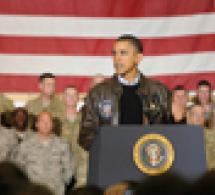 |
 |
Progress in the Afghan War? ISW explores…
Today President Obama spoke to the nation announcing the results of the December Afghanistan war review since he changed strategies and added an additional 30,000 U.S. troops into the battlefield. Politico reports, “The war in Afghanistan is on track to meet the U.S. military’s goals, but it remains a ‘very difficult endeavor,’ President Obama said Thursday as the White House released a review of the war. ‘The gains we've made our still fragile and reversible,’ he said.”
In anticipation of the war review, the Institute for the Study of War (ISW) has produced a two-part report series on the counterinsurgency campaigns conducted by NATO and Afghan forces in Helmand and Kandahar provinces, the heart of the Taliban insurgency. The first report released, Counterinsurgency in Kandahar – Evaluating the 2010 Hamkari Campaign by Carl W. Forsberg, carefully documents the counteroffensive campaign in Kandahar during the summer and fall of 2010. This counteroffensive was part of the broader Hamkari (“cooperation”) process, the term given to the combined civil-military campaign to weaken the insurgency by securing Kandahar and improving governance and development. The report also contains eight new maps of Southern Afghanistan and a graphic charting the phases of coalition military operations from June to November.
Key findings and recommendations:
• Kandahar is strategic terrain because it is the heart of the Pashtun south, the birthplace of the Taliban movement, the former de facto capital of the Taliban government, and the home of President Karzai.
• For the Taliban, contesting Kandahar is important for their attempts to appear a viable rival to the Afghan government.
• Insufficient troop strength from 2005 to 2009 limited ISAF’s ability to target and destroy the enemy strongholds in three key districts: Arghandab, Zhari, and Panjwai.
• After the Surge troops’ operations in Kandahar, many of the fighters in Arghandab, Zhari, and Panjwai laid down their arms when it became clear the Taliban could not resist ISAF assaults. Some joined ISAF cash-for-work programs, which grew from several dozen workers to between 4,000 and 6,000 Afghans a day in Zhari.
• Coalition operations in Zhari also neutralized the enemy attack network along Highway One. In the first 28 days of October 2010 there were no kinetic incidents on the stretch of highway passing through Zhari, a change from early September when the Taliban were conducting five or more attacks a day.
• Despite this progress, restoring the Afghan government’s legitimacy is ultimately an issue of altering public perception, and progress made in building government capacity will achieve little if overshadowed by perceptions of corruption and factional control over the Kandahar government.
Finally, all ISW members are invited to participate in our interactive conference call tomorrow entitled, “Taking Southern Afghanistan Back from the Taliban.” Carl W. Forsberg and Jeffrey A. Dressler, both ISW Afghanistan Scholars, will present the findings from their studies on Kandahar and Helmand at 11 AM EST. Don’t miss this unique opportunity! Not an ISW member? Join us today!
